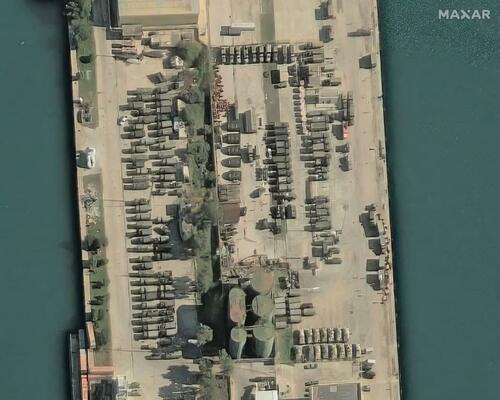Recent satellite imaging has shown that for the past several days Russia is rapidly packing up heavy equipment at its Khmeimim airbase in Latakia and evacuating it in the wake of the collapse of the Assad government on December 8. This is happening even as Moscow is in contact with new governing HTS rulers in Damascus concerning the future fate of the bases, which also includes the strategic naval base at Tartous.
Concerning the packed up equipment, including anti-air missile systems, the only question is what's the next destination? Western officials are now saying Libya. Moscow is putting pressure on Libyan warlord and rival to the Tripoli government, Khalifa Haftar, to secure a larger Russian military presence at a port in Benghazi.

CNN has cited two unnamed US officials who say intelligence has observed the transfer of naval and other assets from Syria to Libya. Flight tracking has also confirmed the same.
"Flight data show at least three Russian military cargo planes have flown from Belarus to Libya since Dec 8, the day the Russian-allied Assad regime in Syria was toppled by Islamist-led rebels," The Telegraph writes. More have reportedly followed this week.
The report continues, "Experts believe that Russia is moving defense materials stockpiled in Belarus, its closest ally, to Libya, where it is rapidly increasing its military presence in response to the rebel seizure of Damascus."
The Wall Street Journal in a fresh Wednesday report also observers:
Russian cargo planes have flown air-defense equipment, including radars for S-400 and S-300 interceptor systems, from Syria to bases in eastern Libya controlled by Moscow-backed Libyan warlord Khalifa Haftar, the officials said.
Russia has also flown troops, military aircraft and weaponry out of Syria in a significant drawdown of its presence there. For years, Moscow has operated important naval bases and air bases in exchange for the support it provided to prop up Bashar al-Assad, the Syrian dictator who fled to Moscow last week.
Libya's Haftar, interestingly enough, maintains positive relations with both Moscow and Washington, but is generally seen as more in alignment with Russia. He has long requested that his part of eastern Libya under his control come under the protection of Russian air defenses.
Given events in Syria, he may actually get his wish. The WSJ notes, "But Haftar will likely face pressure from the West to not allow Russia to expand its presence in Libya. The U.S., including during a visit by CIA director William Burns last year, has repeatedly warned Haftar to expel Russian forces—to no avail."

Since the 2011 overthrow of the Gaddafi government via US-NATO military intervention, Libya has remained in a state of chaos with three and at times four competing governments and swathes of the country controlled by warlords and Islamist factions. But the mainstream media has by and large moved on, unconcerned with the chaos left in the wake of the Obama-Hillary Iraq-style regime change operation.
Recent satellite imaging has shown that for the past several days Russia is rapidly packing up heavy equipment at its Khmeimim airbase in Latakia and evacuating it in the wake of the collapse of the Assad government on December 8. This is happening even as Moscow is in contact with new governing HTS rulers in Damascus concerning the future fate of the bases, which also includes the strategic naval base at Tartous.
Concerning the packed up equipment, including anti-air missile systems, the only question is what's the next destination? Western officials are now saying Libya. Moscow is putting pressure on Libyan warlord and rival to the Tripoli government, Khalifa Haftar, to secure a larger Russian military presence at a port in Benghazi.

CNN has cited two unnamed US officials who say intelligence has observed the transfer of naval and other assets from Syria to Libya. Flight tracking has also confirmed the same.
"Flight data show at least three Russian military cargo planes have flown from Belarus to Libya since Dec 8, the day the Russian-allied Assad regime in Syria was toppled by Islamist-led rebels," The Telegraph writes. More have reportedly followed this week.
The report continues, "Experts believe that Russia is moving defense materials stockpiled in Belarus, its closest ally, to Libya, where it is rapidly increasing its military presence in response to the rebel seizure of Damascus."
The Wall Street Journal in a fresh Wednesday report also observers:
Russian cargo planes have flown air-defense equipment, including radars for S-400 and S-300 interceptor systems, from Syria to bases in eastern Libya controlled by Moscow-backed Libyan warlord Khalifa Haftar, the officials said.
Russia has also flown troops, military aircraft and weaponry out of Syria in a significant drawdown of its presence there. For years, Moscow has operated important naval bases and air bases in exchange for the support it provided to prop up Bashar al-Assad, the Syrian dictator who fled to Moscow last week.
Libya's Haftar, interestingly enough, maintains positive relations with both Moscow and Washington, but is generally seen as more in alignment with Russia. He has long requested that his part of eastern Libya under his control come under the protection of Russian air defenses.
Given events in Syria, he may actually get his wish. The WSJ notes, "But Haftar will likely face pressure from the West to not allow Russia to expand its presence in Libya. The U.S., including during a visit by CIA director William Burns last year, has repeatedly warned Haftar to expel Russian forces—to no avail."

Since the 2011 overthrow of the Gaddafi government via US-NATO military intervention, Libya has remained in a state of chaos with three and at times four competing governments and swathes of the country controlled by warlords and Islamist factions. But the mainstream media has by and large moved on, unconcerned with the chaos left in the wake of the Obama-Hillary Iraq-style regime change operation.
